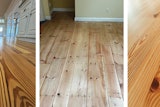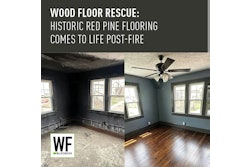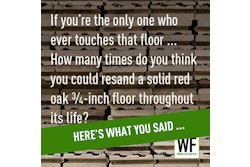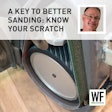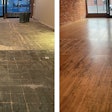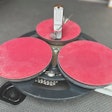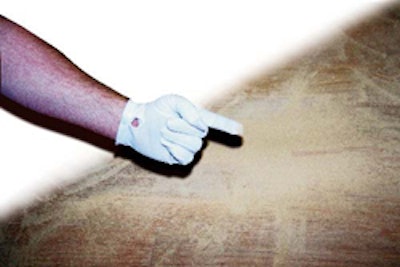
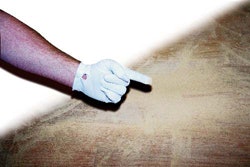
Flip through the Yellow Pages these days, and you may notice something about the wood flooring ads — most of their big print uses phrases like "dustless sanding" and "no mess in your home." Those companies have pinpointed a major customer concern about wood floors — the mess. Plenty of people who love their newly refinished wood floors are also eager to tell how afterwards they had to hire a cleaning service and wash all their drapes — and they still had dust in their house.
With a bad rap like that, it's amazing that as many home owners put in wood floors as they do. It's understandable why some wood flooring contractors are going to great lengths to promote the tidiness of their jobs, some even going so far as to make the unrealistic "dust-free sanding" claim. Obviously, no sanding can be dust-free, but contractors do have an increasing number of products available to them to keep their customers' homes as clean as possible.
Great expectations
A first step in managing dust is to not generate false customer expectations. First of all, although you may see the claim frequently, no sanding job is 100 percent dust-free. Even the best dust-containment equipment available is going to leave some fine dust on the job. Promising customers that their homes will be totally clean can only set them up for disappointment and, sometimes, anger — directed at you.
Take a proactive approach. Explain to customers that although you'll do your best to keep the job site as clean as possible, there will be dust. Even with such a warning, they may not understand to what extent. Take them through a checklist of what's necessary to get the job site ready. Besides the obvious, such as furniture removal, this can include removing artwork, draperies and knick-knacks.
Plastic is cheap. Use it liberally to protect nearly anything in the house. If artwork or other wall hangings aren't removed, they should be covered in plastic. Some contractors cover all the walls and ceilings, especially if they are covered in wallpaper or may be difficult to clean afterwards. Light fixtures may also need to be removed or covered in plastic. (If they are covered in plastic, cut off their power supply at the panel box so the whole job doesn't go up in smoke.) You may also need to cover carpet or other floor coverings leading out of your work area— a trail of Brazilian cherry dust leading through Mrs. Jones' white carpeted living room could be a nightmare to get out.
Plastic should also be used to seal off your space from the outside world. Tape it up at all doorways, and give it a good overlap to further prevent airborne dust from traveling. Covering windows protects them from dust and also helps block intense sunlight, which can cause problems while the finish cures.
Any time you hang plastic, use painter's tape that won't mark or pull wall coverings off. Whenever possible, tape to door jambs instead of paint, and never tape to wallpaper. Actual tape-and-plastic combo systems are available that can make hanging plastic a simpler and faster job. Also, products are available that use jacks to secure the plastic — these can even seal off only part of a room if necessary.
On the move
Even a room that has every inch covered in plastic can spread dust throughout the job site if you don't consider the HVAC system. Its job is to push air through the house. If it does its job well, it will efficiently spread your dust into every room of the house. There are several ways to prevent that. If climate and weather permit, some contractors simply turn the system off while they're sanding and finishing. More commonly, you need to deal with the cold-air returns. If you are sanding only one room, you may be able to simply seal off the return by taping over it with that plastic you've got everywhere else. Otherwise, you can use specially designed filters that cover all the cold-air returns, blocking any dust from being sucked into the system.
Go with the flow
Now you're ready to fire up the dust-makers — the big machine, edger and buffer. Even if you don't have special dust-containment systems on that equipment, there are ways to minimize the dust left behind. Any big machine or edger is already designed to pick up dust and collect it. It does so by using air flow through the machine. One of the easiest ways to maintain air flow is to empty the bags when they are full. That may sound like common sense, but sander and edger bags are actually "full" when they appear to be half full. Most bag manufacturers mark the bag at that halfway mark to remind you. Running the machine as the bag fills beyond that point can actually force dust back out, defeating the purpose of having the bag on at all.
The bags on machines have a specially designed textured nap on the inside that traps dust. The bag's pores are large enough to let air pass through and small enough to trap the fine dust. For this to work, the bag needs to be relatively clean. When you empty the bag, take the time to turn it inside out and shake it well. Most manufacturers also recommend washing the bag periodically (but remember not to put them in the clothes dryer — they shrink).
If while you're running the machine the bag blows up like a balloon about to pop, there's an air flow problem. Either the bag is filthy and not letting enough air through, or its pores are too small to allow air movement. Likewise, some bags have pores so large that they have great air movement, but don't trap enough fine dust. Take these things into consideration when buying bags. When you're in a pinch, resist the temptation to snatch a pillowcase out of the linen closet. It's been done, but not by the most brilliant sanders out there.
By far, the nastiest dust machine is the buffer. In no time, it can create immense clouds of fine airborne dust that can make it hard to see across the room. The skirting or brush systems on the bottomof buffers are designed to help keep that dust on the ground. That's why it's important to keep the skirt in good condition. How you store your buffer can make all the difference. If you store it laying down or on top of a storage pad (you can buy such pads or make your own), the skirt is raised up safely off the ground. If not, the skirt is crushed up, making it impossible to trap dust. (If the skirt is inadvertently crushed, soaking it in very hot water may help to return it to its original shape.)
Another related problem can arise when contractors use aftermarket pad drivers on their buffers. Most manufacturers' pad drivers are slightly different heights. Using one that is not the right dimension can change the position of the skirt to be too high or too low — either way, the machine is less effective.
Routine maintenance procedures that keep your machines running and sanding well are also going to help them pick up dust. Remember one of the easiest parts of routine maintenance — blowing out the machines. It's easy, especially if you've got an air compressor on the job site, and doesn't take long. Keeping the machines clean helps them run well and also helps prevent them from spreading dust back on the job site.
Vac attack
Just as important as the flooring contractor's other machines, the right vacuum is essential to a clean job. Whether you're using it attached to a dust containment system or still only using it between sandings, you need a vacuum designed to do the job.
First, choose a vacuum designed to do heavy-duty, long-term work. Most canister-type vacuums that can be bought at home centers are intended for homeowner use. They are designed to run for short periods of time and to pick up large debris, not fine dust. Because they don't have the filtration systems of professional machines, they don't contain the dust wood flooring sanders create. When shopping for machines, also pay attention to the wheels — most professional machines have soft, non-marking wheels that won't dent or scuff the floor.
Another thing to consider is that, as sometimes happens, bigger is not necessarily better. While contractors may tend buy the biggest machine possible, that may not be what's most effective for the job site. Some smaller vacs may have better air flow than their larger counterparts — in some cases, some backpack vacs have better suction than a canister vac. Also, typical job sites are never going to create enough wood dust to fill a huge vacuum. A large vacuum is cumbersome when full and also takes up lots of space in your van. There's also an inherent safety hazard in having a huge amount of wood dust sitting in a container on the job site (see the sidebar" Horror Stories" at right).
Once you've got the right vacuum, take care of it. Clean the machine and clean the filter according to the manufacturer's recommendations. Some commercial vacs are designed for wet/dry applications — almost all of those require that the filter be removed for wet applications. Pay attention to your hose. Just as using too many extension cords can decrease your power, using hoses that are too long can decrease the effectiveness of the vac. So can holes in the hose. Duct tape, black tape, painter's tape and any other kind of tape should only be an emergency fix for a hole or crack in the hose.
Diligent contractors who are obsessive about the quality of their sanding jobs and subsequent finish coats put the vacuum to work by using it between every sanding with the big machine, edger and buffer.
Be systematic
In recent years, dust containment systems have become increasingly popular among contractors. Most systems rig a vacuum hose directly onto the edger or buffer, usually claiming to keep the job site about 95 percent or more dust-free. The systems may cost more up front, but savvy contractors promote them heavily in their advertising. They also can charge more for the service, just as they would for putting in a higher grade of wood or a better quality finish.
There are other practical benefits to using a dust containment system. For one thing, they make visibility on the job better. Since the floor is much cleaner as you're working, it's easier to see what you're doing. That results in a better job and saves time going back and, for example, buffing a rougher spot you missed the first time around. It also saves time on preparation — some contractors who use the system don't even hang plastic — and saves time on clean-up.
Using a dust containment system also helps project a professional image to the customer. It sends a message: "I care about your home and the incredible mess I would have created."
If you don't want to invest thousands of dollars in new equipment, there are retrofit options. Some manufacturers offer retrofit options specifically for their non-dust-containment equipment, and other suppliers offer generic retrofit kits as well. Just be sure that the retrofit is totally compatible with your machine, and have a trained technician do the job.
Dusty dangers
Tiny bits of wood dust aren't just annoying to the home owner — they're the enemy of any wood floor finish. You may have swept, vacuumed and tacked the last coat of finish after buffing it, but if you walked across the dusty plastic that covers the white living room carpeting on your way to applying the last coat, your shoes are going to spread the dust right back out through the finish. Don't sabotage all your diligent work up to that point— be aware of the dusty dangers up until the moment the finish is dried. You'll have a job you can be proud of, your customer will be satisfied, and more referrals will come your way.
Dust Control for Your Lungs
Any time hazardous materials are present, employers are required by law to comply with OSHA’s respiratory protection standard (state law may also require this). Employers are responsible for determining which workplace applications require respiratory protection and then providing it. Although you may not think of it as dangerous, wood dust is a hazardous material — be sure your employees are trained in why they should wear a respirator, which kinds are available, how they fit, and how to maintain them. It may seem like a hassle, but it’s the law, and it’s also vital to your employees’ health.
Horror Stories
Most wood flooring contractors can tell at least one horror story about themselves or someone they know and spontaneous combustion. Sometimes it involves stain rags, but oftentimes it’s because of dust. Wood dust is not only a problem because of the mess it makes, it can literally destroy your business. Full dust bags left on the job site, in your van or in your shop can begin to smolder and burst into flames. That’s why it’s essential that dust bags be emptied every time you leave the job site — even if it’s only for a lunch break. Don’t let your customer’s home or your business go up in smoke.










